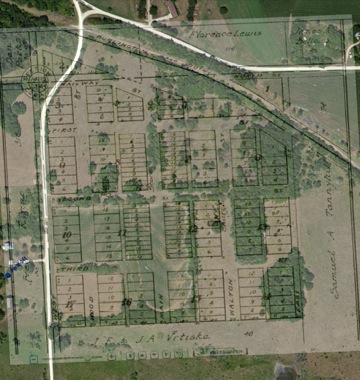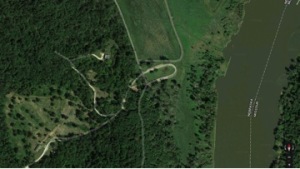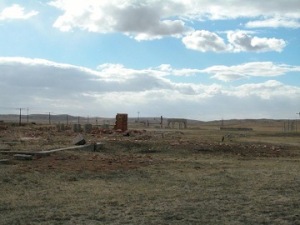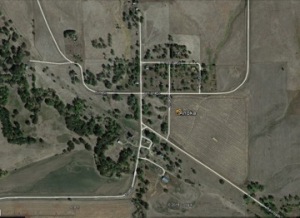
Overlay of the plat map of the village of Violet (originally Butler) over the current site showing the correspondence between trees and streets
Ghost towns evoke images of dusty streets, ramshackle buildings, and tumbleweed. Popular imagination places them in the high peaks of the Rockies or isolated in the deserts of the Great Basin and the South West. However, Nebraska has its own ghost towns, silent witnesses to the state’s agricultural and transportation history. They also speak to the optimism of the state’s settlers, their aspirations, and the challenges they faced on the frontier. These lost communities are easy to miss while driving along the state’s highways, but with some basic detective work, they arise out of the landscape to tell their story.

All that remains of the village of Edholm in northern Butler County are two grain elevators and the town cemetery
Often, the quickest means of discovering Nebraska’s ghost towns is to consult historic maps. Many former communities were established by land development companies or other private land holders, who in the process had town sites surveyed and platted. Comparison between current and historic maps, especially historic railroad maps, helps to identify ghost towns. Aerial photographs also assist in the discovery of these towns, revealing features that are hidden at ground level, such as building foundations, roadbeds, and railroad rights-of-way. Finally, county histories, newspapers, and oral histories also point to the locations of ghost towns.

Former site of St. Deroin in Indian Cave State Park. St. Deroin was an important Missouri River crossing and was one of the earliest towns established in Nebraska, but declined following a shift in the course of the Missouri. Nearly all of the town site was swept away by floods in 1911 and 1920
Railroad ghost towns are the easiest to identify due to their larger size, physical remains, and higher number. Often, these towns were large enough to have graded streets, which are still visible in the landscape. These streets may still be shaded by trees planted by the original settlers. Isolated grain elevators also often indicate a former town, especially when they are oriented at an angle against the common grid of county roads, implying a location along a long-abandoned railroad. Many of these towns were founded during the period of railroad expansion, 1870-1890, and were abandoned by the late 1930s due to the collapsed agricultural economy and the closure of railroad branches.
Another class of ghost towns includes former river settlements. These towns were primarily located at fords or ferry sites along Nebraska’s multiple rivers, and are among the earliest settlements in the state. The sites of these communities often have few, if any remains such as streets or structures, due to floods or changing river courses.

The town of Antioch once boasted over 1,000 inhabitants during the Potash Boom of WWI. However, nothing remains of the town’s temporary structures and streets in southern Sheridan county, except for some factory ruins
Other ghost towns include speculative settlements, constructed to serve as possible sites for county seats, or as possible railroad depots, or as future centers for an industrial or agricultural area. These settlements are the hardest to find, as they often were in existence for the shortest period of time and were composed of the most temporary of buildings. These settlements are primarily found only on old maps, and have left little impression on the landscape, except for place names, groves of trees, or possibly a cemetery.
Nebraska’s ghost towns, while not as visually impactful as the mythologized ghost towns of the far west, are a key part of the state’s history and are a target for investigation and preservation. Much can be learned from these town sites, which provide us clues on not only the economic and material aspects of prairie life, but also give insight to how people planned for the future and saw their relationship between their community and the larger world.

The village of Anoka was established by the Pioneer Town Site Company in 1903 along the Chicago and Northwestern Railroad. A substantial railroad town in its day, only the streets, a grain elevator, and a store building remain of the town buildings
– Ruben Acosta / National Register and CLG Coordinator, State Historic Preservation Office



